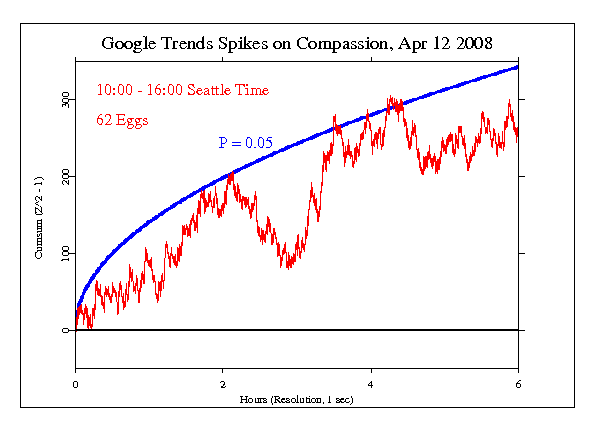Google Trends Spike for Compassion |
|
Google Trends is one of several measures that may give some quantitative indication when special moments capture the attention of large numbers of people. While much of what is displayed in Google Trends has to do with popularity or excitement, the database is so huge that it is possible to search for and find more interesting things for examination as possible correlates to deviations in the GCP data. For example, on Sept 21, 2011 I put in the word "compassion" as a search term, which produced a graph running from 2004 to the present. The largest spike in the "search volume index" by a considerable margin was on April 12 2008, and it was attributed to the Dalai Lama speaking of compassion and leading many thousands of people to think and feel connected with this manifestation of true humanity. The Seeds of Compassion gathering April 11-15, 2008, in Seattle, WA, was an "unprecedented gathering to engage the hearts and minds of our community ... anchored by the deep wisdom of His Holiness the Dalai Lama." The community-focused event celebrated and explored the relationships, programs and tools that nurture and empower children, families and communities to be compassionate members of society. I was not able to get precise timing, but this was a daytime event which likely started in the morning. I set this exploratory event to begin at 10:00 and end 6 hours later at 16:00, Pacific time. The result is a positive deviation with Chisquare 21856.166 on 21600 df for p = 0.109 and Z = 1.231. This is the first in a series of explorations like it, which will be compounded. The Z is 4 times the average for single events, and as such is promising.

It is important to keep in mind that we have only a tiny statistical effect, so that it is always hard to distinguish signal from noise. This means that every "success" might be largely driven by chance, and every "null" might include a real signal overwhelmed by noise. In the long run, a real effect can be identified only by patiently accumulating replications of similar analyses.
|